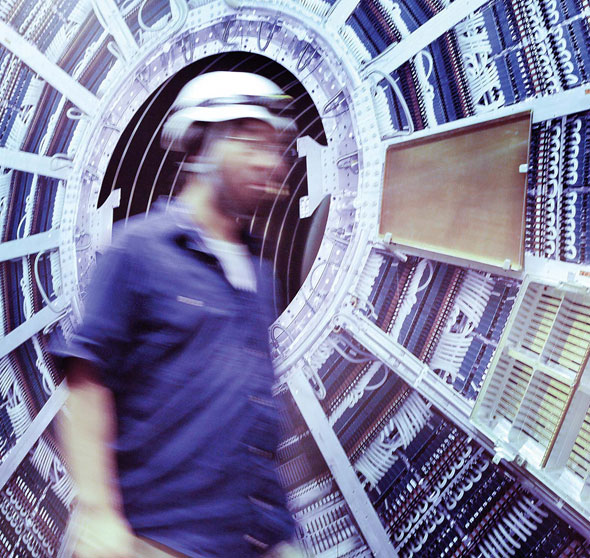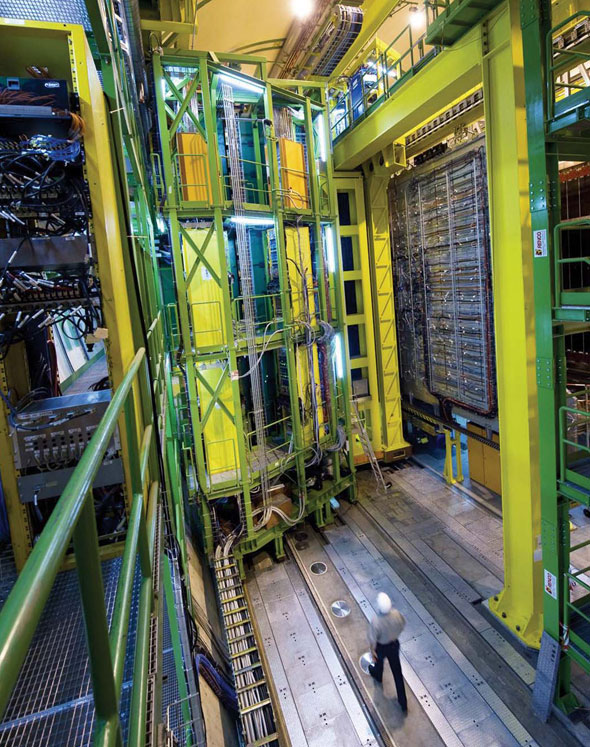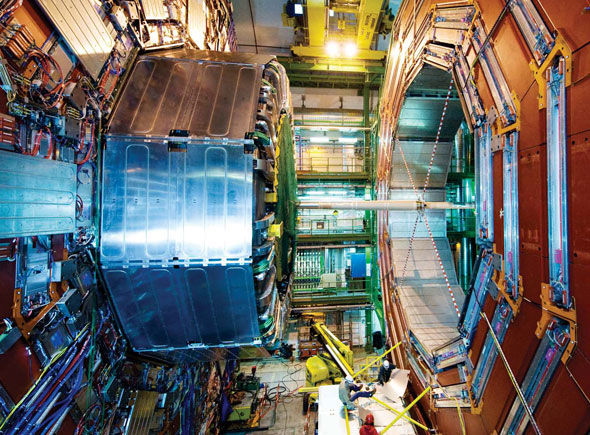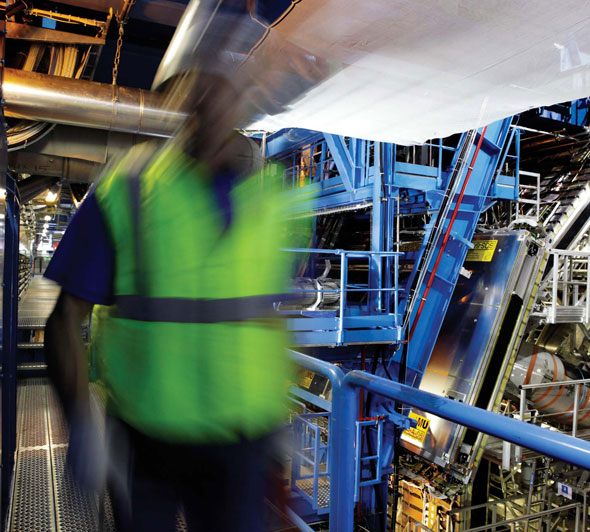Not a moment to lose at the LHC
Physicists from the Large Hadron Collider's experiments turn an unexpected shutdown to their advantage.
By Kate McAlpine
 |
|
| Photo: C. Marcelloni, ATLAS experiment, CERN | |
| The eyes of the world were on the Large Hadron Collider at CERN on September 10, 2008. On that day, dubbed "Big Bang Day" by the BBC, the first beams of subatomic particles zoomed around the 17-mile-long, super-cooled particle accelerator. Three hundred feet below the Swiss-French border near Geneva, the LHC had been more than 20 years in the making. It was designed to bring particles into collision at energies high enough to recreate conditions last seen a fraction of a second after the big bang. Everything went smoothly on Big Bang Day. But less than two weeks later, a connection between two superconducting magnets failed, setting off a chain reaction that would damage 53 of the accelerator's 1624 main magnets and require a full year to fix. Physicists at the LHC's four major experiments had been eagerly anticipating the first collisions, which would have taken place about a month after the first beams. While those initial collisions would have been too low in energy to reveal new truths about the universe, they would have provided vital information about the inner workings of the LHC's brand-new, incredibly complex, one-of-a-kind detectors. But even with the accelerator shut down, there has been no time to relax. Physicists not involved in major repairs to the collider have been busy upgrading both equipment and software, making minor fixes that originally had been scheduled for the LHC's first winter shutdown, and repairing nagging problems that cropped up during years of construction. Most of this work is routine, part of the ordinary process of commissioning a new accelerator, says James Gillies, head of communication for CERN. "It's part of the normal process," he says. "When you really are pushing the limits of technology, things like this can happen. That's one of the ways technology advances." Here's a look at a few of those projects. |
 |
|
| ALICE Photo: C. Marcelloni, ATLAS experiment, CERN | |
ALICE: Doors that make a sloth look quick
Physicists are always looking for ways to improve and enhance their experiments, whether through small changes to software or the addition of whole new sets of detectors. The year-long shutdown gave the scientists of ALICE, one of the LHC's four large experiments, a head start on installing their newest subdetector system.
Subdetectors measure the trajectories, energies, and arrival times of particles that pass through the detector. Each subdetector is tuned to specific types of particles. It's up to the physicists to build a coherent picture of what happened in a given collision by stitching together millions of pieces of such information.
ALICE's newest subdetector system, a joint contribution of the 13-institution ALICE-USA collaboration and CERN, is made up of 11 eight-ton electromagnetic calorimeters that absorb and measure the energies of electrons and photons, or particles of light.
The first step in the installation was to open the massive doors of the L3 magnet, which had been recycled from a previous experiment in the cavern. This gigantic red shell curves the paths of charged particles such as electrons, allowing physicists to measure their speeds and masses. Opening the magnet's doors takes a full day. Each door is 90 feet tall and 30 inches thick, and weighs 430 tons. As the hydraulically driven doors swing out to a 90-degree angle, they move slower, on average, than the hour hand of a watch.
With the doors open, the first electromagnetic calorimeter module was lowered 150 feet into the cavern, already locked into the yellow frame of its installation tool. Then the tool's internal motors rotated the module into the proper alignment.
"You slide it in on rails, and then you simply lock it on the rails such that it cannot move anymore," explains Werner Riegler, ALICE's deputy technical coordinator. Once it was in place, the calorimeter teams brought the module to life, connecting it with cooling, electricity, and datacarrying fibers. Four of the modules will be installed by the time beams are back in the LHC; the rest should be in place by 2011.
 |
|
| Photo courtesy of CERN | |
LHCb: Those hard-to-reach places
Throughout the six years of the LHCb experiment's construction, workers were continually building, tearing down, repositioning, and rebuilding the ladders and scaffoldings that allowed physicists, engineers, and technicians to get to hard-to-reach places. The arrival of the first LHC beams signaled the end of construction; now the way was clear for the installation teams to build the permanent staircases, handrails, and platforms needed to safely reach and maintain the thousands of intricate parts that make up the LHCb detector.
One set of cooling valves looked as if it could be reached from a platform above. But the platform was just far enough away that "you would need one-meter arms" to grab the valves, says LHCb Installation Coordinator Rolf Lindner feasible for 7'6" basketball player Yao Ming, perhaps, but not for the average particle physicist. What's more, when contractors discovered they couldn't reach the valves from above, they started using the cooling pipes that ran beneath the valves as a ladder, which was not good for the equipment.
LHCb needed a real ladder, one that couldn't be found at a hardware store. So the LHCb experimental area team specially designed a ladder topped with a platform. Contractors built the parts from aluminum, a metal immune to the high magnetic fields that will be generated by LHCb's powerful dipole magnet. Finally the parts were lowered into the cavern, drilled with a few holes and bolted into place.
 |
|
| Photo courtesy of CERN | |
CMS: Drip, drip, drip
For the CMS experiment, leaky pipes were a problem. As Gerd Fetchenhauer of RWTH Aachen University in Germany put it, "Sometimes you see water on the floor and you think, Where the hell is that coming from?'"
Chasing down the leaks is no easy feat. CMS's 16 main cooling circuits deliver water to 3500 locations around the cavern, Fetchenhauer says. Puddles on the cavern floor may have started as drops trickling from anywhere in the 49 feet of detector equipment above. "The tricky part is really to guess where it came from and where it leaked into on its way," says CMS Experimental Area Manager Martin Gastal.
Finding the leaks is the job of a team of plumbing private eyes from the Polish company ZEC. The team has been working at CMS for seven years, first laying 130 miles of copper and 80 miles of stainless steel pipe for gas and cooling, then connecting individual detectors to their plumbing lines, and now fixing leaks in plumbing that was installed before pressure testingwhich reveals weak spots in the piping became mandatory.
The plumbers are aided by a monitor that measures the outgoing water against incoming flow. An easily accessible problem can be fixed in a few minutes with standard plumbing adhesives and thread-sealing tapes. More challenging fixes can take two days.
That was the case for a leak that sprang during a test run of the CMS detector. CMS is arranged in 11 massive slices, each weighing up to 2000 tons, mounted on special pads that generate a cushion of air and allow them to easily slide across the floor. When the detector is in operating mode, the slices are jammed together with just a few centimeters between them. When workers need access, the slices can be pulled up to three meters apart.
This particular leak, caused by vibration in the cooling pipes, appeared high in one of the five inner slices. Four slices had to be moved so plumbers could ride up in the basket of a cherrypicker crane and seal a fitting.
 |
|
| Photo: C. Marcelloni, ATLAS experiment, CERN | |
ATLAS: Practicing on rays from space
In experiments that push the limits of technology, glitches are inevitable during the first years of operation. ATLAS physicists took advantage of the shutdown to fix problems with the calorimeter systems, subdetectors that absorb particles and measure their energies.
An American company refurbished a set of power supplies associated with the electromagnetic calorimeter over the winter, and scientists began reinstalling them in the spring. Meanwhile, the hadronic calorimeter, which measures the energies of proton-like particles, needed work on 80 of its 256 "drawers." Each drawer contains sensors and electronics that independently process data from the calorimeter. During testing, physicists had noticed that some of the channels sent out incorrect data or no data at all; with repairs complete, more than 99 percent of the subdetector now functions correctly.
Even as repairs were going on, ATLAS' subdetector systems stretched their legs with weeks of practice in gathering data from cosmic rayshigh-energy particles from outer space that constantly bombard the Earth, and the LHC experiments.
"For most of these runs, we worked with only half of the electromagnetic calorimeter," says CERN's Martin Aleksa. "However, on the weekends, we took data with the full system, and the full system worked."
Taking cosmic-ray data allows the subdetector systems to sync up with changes to ATLAS software, as well as adjust the timing and alignment within a subdetectorboth critical to precisely measuring particles as they pass through multiple systems. Eventually all repairs were complete and ATLAS once again operated as a whole with all detector groups running simultaneously, checking timing and alignment against one another.
Improvements: A never-ending quest
The unexpected delay in the start-up of the Large Hadron Collider was far from a blessing in disguise. The detectors were fully prepared for collisions at the time, and the collaborators hungry for data to analyze in search of physics discoveries. They're hungry still. But they know that a big accelerator is always something of a work in progress, and they expect to keep maintaining, building on, tweaking, and improving the LHC detectors right up to the end of the collider's long lifetime.
Click here to download the pdf version of this article.






